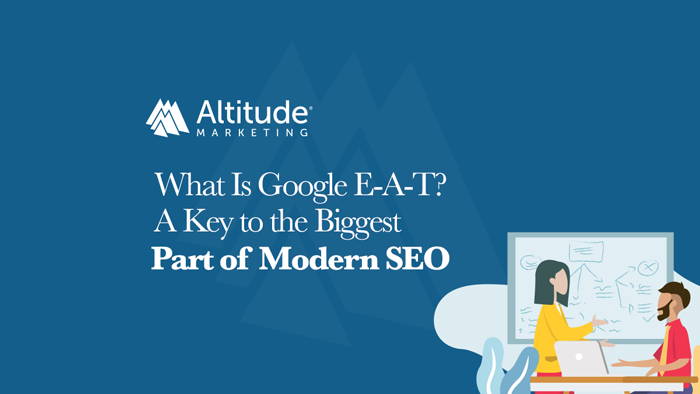If you run a B2B website, there’s a good chance you’ve heard of Google’s “E-A-T” guidelines. There’s an equally good chance you don’t know much about them.
In this post, we’ll address the question “What is Google E-A-T?” We’ll go into the history of the term and the implications of getting it right (and wrong). Finally, we’ll look at ways to improve E-A-T and SEO.

Contents: What Is Google E-A-T?
What Does E-A-T Stand For?
Google’s E-A-T acronym is short for “Expertise,” “Authority” and “Trustworthiness.” These are key components of any website – though more for some than others, as we’ll cover.
Google is looking for content that offers high-quality advice from a credible source.
“Expertise” and “authority” are closely related to one another. It’s important to remember that, when speaking about E-A-T, both are contextual. In other words, a site or writer need to be authoritative in a relevant topic. A massive, unfocused site will often lose on a SERP to a smaller, focused site when the content matches the smaller site’s niche.
“Trustworthiness” is shorthand for “would you give your credit card to this site?” We’re not just talking about eCommerce sites here. Think of the harbingers of trust on the web:
- An SSL certificate
- A professional (or professional-ish) design
- Few typos
- Relevant content dating back a fair bit
- A real domain name
Trustworthiness in Google E-A-T is a sniff test. You’ll know it when you see it – and amazon.ezfunding123.biz doesn’t have it.
The History of E-A-T
Google E-A-T as a formal concept dates back to the September 2018 core update, known as “Medic.” The algorithm change got its name from a focus on improving the quality of “Your Money, Your Life” sites. Many of these YMYL sites deal with medical advice; hence, Medic.
Google has long distributed guidelines to its team of 10,000+ search quality raters. After Medic, the document started speaking to E-A-T as the core measure of site quality.
How important is E-A-T, per the guidelines? Well, the word “keyword” appears seven times in the current 168-page iteration. “E-A-T” shows up 135 times, or almost once per page. Search Quality Rating Guidelines are a rare peek into the algorithm itself, and E-A-T is A Big Deal.
Why it Matters for Your Website
There is a school of thought on SEO forums that E-A-T only matters for YMYL sites. After all, those were the sites that saw the biggest swings after Medic, and are most explicitly called out in the guidelines.
That’s right … and wrong.
It’s true that Medic (and its E-A-T progeny) was targeted at YMYL sites. Google doesn’t want its users getting financial or medical advice from charlatans. It’s clear that focusing on E-A-T addresses that quite well.
However, there’s every reason to believe that non-YMYL sites are affected by the E-A-T focus, too.
Why?
Think about it. A “high E-A-T” site shows:
- Expertise in a given subject
- Authority in a given subject
- That it can be trusted
E-A-T aside … that’s pretty much a prescription for a good website.
Remember, the only way to rank sustainably is to make the best possible site about a topic. The best possible site about a topic would have … expertise, authority and trustworthiness.
So, even if you don’t run a site focused on consumer advice, you should still pay attention to E-A-T.
Improving Expertise, Authority and Trustworthiness
So, how can your website increase its Google E-A-T?
First, know one thing: There is no such thing as an E-A-T score. Thus, E-A-T is not a direct ranking factor in the Google algorithm. It’s not like your Performance, where you can try to increase from, say, 50 to 75. E-A-T is more art than science.
That said, there are a few things you can do to up the ante.
- Include bios for blog authors and leadership team members. A non-human entity can’t be an expert, and your people can’t be experts unless you describe their qualifications.
- Cite your certifications and memberships. Badges matter; they’re natural indicators of authority.
- Include logos of real clients. If the Fortune 100 trusts you, the three-person startup down the street will, too.
- Proofread your site. Typos and unreadable prose are not indicators of authority.
- Write. A lot. Your goal should be to answer every possible question about your site’s topic. You’ll need a lot of content for that.
- Lock down your security. SSL certificates and up-to-date CMS versions aren’t optional.
- Build a backlink portfolio naturally. Good content and solid influencer relationships beg for links. The more links, the more authority. The more authority, the more E-A-T.
tl;dr: The Key to Great SEO
Yes, even if you don’t have a YMYL site, Google E-A-T could be your key to better rankings and more leads. It’s important to remember that E-A-T is not a goal in and of itself. A high E-A-T site will inevitably succeed at broader SEO factors; it’s just a manner of thinking.
So show the world that you’re an expert. Flaunt that authority. And make clear that you’re trustworthy. Once you’ve made that case, you’re good to go.



